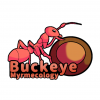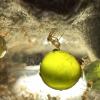Sorry I don't update this journal as much as I probably should. I just am always busy doing other things, such as pinning ants or making formicaria or whatever else I'm doing. Anyways, I'm gonna try and update it more, so here we go.
I've been collecting tons of Crematogaster gynes lately, as they seem to fly a lot during late Fall and early Winter. I currently have 10 lineolata queens and 1 ashmeadi queen. While on the subject of Crematogaster, I don't think I ever addressed this, but a few months ago I collected a large colony of C. minutissima, but I kind of forgot about them for like two whole months, but I've finally remembered I had them, checked on them in the temporary (hehe, temporary) holding container, just a pill bottle with a large, wet cotton ball. I looked in and all I saw was mold and a few dead ants on the cotton ball. I assumed they were all dead and took the cotton ball out so I could clean out the pill bottle, only to see dozens of them poor out. They're still alive and thriving with tons of brood! Also, dang are their eggs big. The colony has around 50 workers and 12 queens with tons of brood, mostly young larva. I've moved them into a test tube setup and they're doing very well. I love those little guys, and it's so cute when they get angry. They're like little scorpions! They produce more venom (proportionally) than other Crematogaster species, and it's actually pure white. It's also very sticky. Anyways, I have high hopes for these little guys.
So I still have that Gnamptogenys triangularis queen, and she is doing quite well and is now out of hibernation. However, she did scare the crap out of me the other day. So I moved her into a new, larger test tube and gave her a fairly large millipede to munch on (a little Plectroctena reference for you there). I check on her a few minutes later only to see her on the floor of the test tube with her last two pairs of legs in the air. I immediately removed the millipede and took the queen out of the test tube to check on her. Her front pair of legs were working just fine, but her last two pairs of legs were still stuck in an upward-facing position and immobile. The tip of her gaster (the bit curled under the body) was also extended. I put her back into the test tube, extremely worried for her. I went to NC for the day, and when I came back, she was just fine, as if nothing had happened. Her gaster and legs were back to normal, and she was just sitting there like always. I'm guessing the reason she was acting so strange is either a) she was not used to that particular species of millipede, which I think was a juvenile American Giant Millipede, or because the millipede was so large, she couldn't take all of the poison the cut body was producing. In either case, she's fine now and I've learned a lesson about giving her such large millipedes. From now on I'll just stick to giving her Greenhouse Millipedes and other small species, never again such a large species.
I've had a large colony of Cyphomyrmex rimosus for a little under a month now, and at the moment they seem to be thriving. They have tons of yeast, have only had one small die-off, and seem to enjoy their custom-designed Attine-style lab formicarium. I need to water them twice a week, and if I do that they should be just fine, as that is what I kept doing wrong in the past, not enough humidity. The only problem I have with keeping them at the moment is the fact that finding caterpillar frass in the middle of winter is no easy task. I've had to revert to feeding the bits of bird droppings, which they seem to tolerate as their yeast is doing very well.
So the large colony of Aphaenogaster cf. rudis I've had for a while now ended up being A. carolinensis. A few weeks ago I forgot to water them and they had a huge die-off of over hall the colony. They've been reduced down to about 30 workers and a small amount of brood. I've moved them into a lab-style formicarium and they seem to like it a lot better. They also did have male brood but I think they ate it.
I'm doing some modifications to the formicarium that houses my Aphaenogaster lamellidens and large Camponotus castaneus colonies. I'm widening the entrance with a dremel, and I am going to move the Aphaenogaster into a lab-style formicarium so I can keep a close eye on them, as the colony is still very young, and also I wanna have a better look at such pretty ants. The Camponotus are doing very well in their new formicarium, and I can now see them a lot better, and even the queen, though there tends to be a lot of condensation on the front panel the disrupts my view of them. If anyone knows how I can solve this problem, please let me know, as I would like to make some high-quality videos of them. Also, I do have a smaller castaneus in hibernation at the moment with 10 workers and a small amount of small brood. I also found a medium sized colony in the wild I could not find the queen of that has a huge amount of small brood, so I will cleanse them of all pheromones and introduce them to the small colony.
How do you forget about a colonies existence.




















